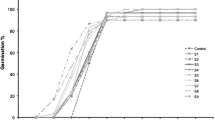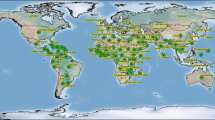Abstract
Adult hoverflies feed on pollen, nectar and honeydews. Thus, the implementation of floristically diverse resources in agroecosystems can enhance biological control of pests by increasing populations of these natural enemies. The objective of this work was to study the effect of seven species of Asteraceae (Andryala integrifolia L., Anthemis arvensis L., Calendula arvensis L., Carduus tenuiflorus Curtis, Chamaemelum nobile (L.) All., Coleostephus myconis (L.) Rchb.f. and Crepis vesicaria L.) on adult longevity and nutrient levels of Episyrphus balteatus (De Geer) (Diptera: Syrphidae). Crepis vesicaria and C. nobile gave the highest mean longevities while, for the other plant species, longevities were not significantly different from those in the water only treatment. In addition, all species tested resulted in significantly lower longevities than the positive control (glucose). In terms of nutrient levels, C. nobile generated high levels of total sugars and C. vesicaria high levels of lipids which suggests the consumption of flower resources. However, the majority of the plants tested would not allow hoverflies to complete their life cycle. Thus, further experimentation needs to be done before considering these plants for implementation in agroecosystems.


Similar content being viewed by others
References
Belliure B, Michaud JP (2001) Biology and behavior of Pseudodorus clavatus (Diptera: Syrphidae), an important predator of citrus aphids. Ann Entomol Soc Am 94:91–96
Böller EF, Häni F, Poehling H-M (2004) Ecological infrastructures: ideabook on functional biodiversity at the farm level. Temperate zones of Europe. IOBC/WPRS commission on Integrated Production Guidelines and Endorsement, Lindau, Germany, p 212
Branquart E, Hemptinne JL (2000) Development of ovaries, allometry of reproductive traits and fecundity of Episyrphus balteatus (Diptera: Syrphidae). Eur J Entomol 95:165–170
Bugg RL, Colfer RG, Chaney WE, Smith HA, Cannon J (2008) Flower flies (Syrphidae) and other biological control agents for aphids in vegetable crops. University of California. Division of Agriculture and Natural Resources. Publication 8285. California, USA, p 25
Bugio G, Sommaggio D (2007) Syrphids as landscape bioindicators in Italian agroecosystems. Agr Ecosyst Environ 120:416–422
Chen L, Fadamiro HY (2006) Comparing the effects of five naturally occurring monosaccharide and oligosaccharide sugars on longevity and carbohydrate nutrient levels of a parasitic phorid fly, Pseudacteon tricuspis. Physiol Entomol 31:46–56
Colley MR, Luna JM (2000) Relative attractiveness of potential beneficial insectary plants to aphidophagous hoverflies (Diptera: Syrphidae). Environ Entomol 29:1054–1059
Cunha AP, Ribeiro JA, Roque OR (2007) Plantas aromáticas em Portugal: caracterização e utilizações. Fundação Calouste Gulbenkian, Lisboa, Portugal, p 328
Dziock E (2006) Life-history data in bioindication procedures, using the example of hoverflies (Diptera, Syrphidae) in the Elbe floodplain. Int Rev Hydrobiol 91:341–363
Fadamiro HY, Chen L, Onagbola EO, Graham LF (2005) Lifespan and patterns of accumulation and mobilization of nutrients in sugar fed phorid fly Pseudacteon tricuspis. Physiol Entomol 30:212–224
Gilbert FS (1981) Foraging ecology of hoverflies: morphology of the mouthparts in relation to feeding on nectar and pollen in some common urban species. Ecol Entomol 6:245–262
Gilbert FS (1983) The foraging ecology of hoverflies (Diptera: Syrphidae): circular movements on composite flowers. Behav Ecol Sociobiol 13:253–257
Haenke S, Scheid B, Schaefer M, Tscharntke T, Thies C (2009) Increasing syrphid fly diversity and density in sown flower strips within simple versus complex landscapes. J Appl Ecol 46:1106–1114
Holloway BA (1976) Pollen-feeding in hover-flies (Diptera: Syrphidae) New Zealand. J Zool 3:339–350
Ksantini M (2003) Contribution à l`étude de la dynamique des populations du psylle de l`olivier Euphyllura olivina (Costa) (Homoptera—Sternorhyncha—Aphalaridae) et de sa nuisibilité dans la région de Sfax. PhD Thesis. Faculté des Sciences de Sfax, Sfax, Tunisia
Landis DA, Wratten SD, Gurr GM (2000) Habitat management to conserve natural enemies of arthropod pests in agriculture. Annu Rev Entomol 45:175–201
Langoya LA, van Rijn PCJ (2008) The significance of floral resources for natural control of aphids. Proc Neth Entomol Soc Meet 19:67–74
Laubertie EA, Wratten SD, Hemptinne J-L (2012) The contribution of potential beneficial insectary plant species to adult hoverfly (Diptera: Syrphidae) fitness. Biological Control 61:1–6
Lentini F, Venza F (2007) Wild food plants of popular use in Sicily. J Ethnobiol Ethnomed 3:15
Lundgren JG (2009) Relationships of natural enemies and non-prey foods. Series: progress in biological control, vol 7. Springer, Heidelberg, Germany, p 453
Robinson S (2011) Plant—pollinator interactions at Alexandra Fiord, Nunavut. Trail Six 5:13–20
Scholz D, Poehling H-M (2000) Oviposition site selection of Episyrphus balteatus. Entomol Exp Appl 94:149–158
Schowalter TD (2006) Insect ecology. An ecosystem approach, vol 2. Elsevier, Burlington, USA, p 572
SPSS Inc., IBM Company (2010) IBM, SPSS statistic for windows, version 19.0.0. New York, USA
Sulborska A, Weryszko-Chimielewska E (2007) Anatomy and ultrastructure of floral nectar of Inula helenium L. (Asteraceae). Act Soc Bot Pol 76:201–207
Tenhumberg B, Poehling HM (1995) Syrphids as natural enemies of cereal aphids in Germany: aspects of their biology and efficacy in different years and regions. Agr Ecosyst Environ 52:39–43
Tooker JF, Hauser M, Hanks LM (2006) Floral host plants of Syrphidae and Tachinidae (Diptera) of Central Illinois. Ann Entomol Soc Am 99:96–112
van Handel E (1985a) Rapid determination of glycogen and sugars in mosquitoes. J Am Mosquito Control 1:299–301
van Handel E (1985b) Rapid determination of total lipids in mosquitoes. J Am Mosquito Control 1:302–304
van Rijn PCJ, Wäckers FL (2010) The suitability of field margin flowers as food source for zoophagous hoverflies. IOBC/WPRS Bull 56:125–128
Wäckers FL (2001) A comparison of nectar- and honeydew sugars with respect to their utilization by the hymenopteran parasitoid Cotesia glomerata. J Insect Physiol 47:1077–1084
Wäckers FL, Romeis J, van Rijn P (2007) Nectar and pollen feeding by insect herbivores and implications for multitrophic interactions. Annu Rev Entomol 52:301–323
Acknowledgments
This study was financially supported by FEDER Funds throughout Programa Operacional Factores de Competitividade—COMPETE and National Funds throughout FCT—Fundação para a Ciência e Tecnologia, within the project PTDC/AGR-AAM/100979/2008—Increasing functional biodiversity in olive groves to enhance conservation biological control of insect pests.
Author information
Authors and Affiliations
Corresponding author
Additional information
Handling Editor: Patrick De Clercq.
Rights and permissions
About this article
Cite this article
Pinheiro, L.A., Torres, L., Raimundo, J. et al. Effect of seven species of the family Asteraceae on longevity and nutrient levels of Episyrphus balteatus . BioControl 58, 797–806 (2013). https://doi.org/10.1007/s10526-013-9535-x
Received:
Accepted:
Published:
Issue Date:
DOI: https://doi.org/10.1007/s10526-013-9535-x




